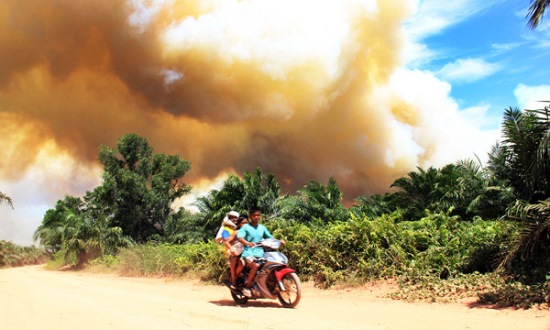As a small island that is typical with almost 80% of the population living in coastal areas, Tarakan island in North Borneo, is vulnerable to climate change impacts such as rising sea levels and extreme conditions of the La Nina storms and waves. The study of risk and adaptation to climate change on Tarakan was implemented by the Ministry of environment (MOE) with several parties in 2010-2011 and the result socialized at the end of last May.
Deputy III MOE, Environmental degradation and climate change affairs, Arief Yuwono, said that studies carried out in order to produce recommendations for adaptation strategies of coastal regions in Indonesia. “This pilot project, Tarakan represents eco-system island which also reflects Indonesia as an archipelago,” he said.
Research shows that Tarakan that is on a small island covering of 250,80 km2 it had a trend rise in air temperature continuously. There is a increase trend of 0.63 ˚C throughout the last 25 years or of 0.2 ˚C within 50 and 100 years.
“Research was conducted to find out how far the impacts of sea level rise on the current and potential impact in the year 2030. The rise of sea level is undoubtedly needs to be adapted, as early as possible,” said Hamzah Latief, oceanography lecturer at Institut Teknologi Bandung (Bandung Institute of Technology) who became an expert team research of coastal and marine areas.
Based on projections, the rise sea levels on Tarakan will reach approximately 14.7 cm by 2030, relative to current conditions. La-Nina phenomenon and storm surge was predicted to raise the maximum sea by 15 cm and 30 cm, the maximum tide reached up to 160 cm.
Climate change can also be seen from the variability of rainfall and temperature in the form of extreme events, particularly drought due to low rainfall. Drought in Tarakan is the potential dangers of climate which is much influenced by the El-Nino phenomenon. Tarakan ever had a long drought on 1961-1970an. According to the prediction model of the rainfall, drought is likely to be repeated in 2010-2020. Later turns into going up trend after the year 2030 based on IPCC model.
Beside drought, other extreme event is the high rainfall in a relatively short time. An example occurred in August, 1, 1998 with a value of 195 mm/day. According to the IPCC model, the probability of the occurrence of rainfall amounted to 433 mm/month continued to decline until around 2020 and rising again thereafter.
The research team then proposed three types of strategic adaptation concepts that are recommended to the Tarakan Government. The North coast of Tarakan that is dominated by dense jungle, swamps and mangrove forests proposed mainly to coastal mangrove and woodland restoration. The west coast of Tarakan which is populous, proposed primarily for accommodation approach such as raise the basic high of building floor.
Tarakan’s East coast has coastal tourist areas that can be useful in the future, namely Amal Beach. However, the construction should be limited because of the potentially high abrasion due to high wind waves from the Makassar Strait. Therefore, proposed the concept of integrated coastal zone management (ICZM) especially with rearrangement or re-examined, determination of retreat line, and coastal protection either through soft structures such as green belt and beach nourishment as well as hard as sea wall and sea dike.
Priority of adaptation based on very high-level of risk toward the danger of sea water puddle especially in five villages namely Sebengkok and Selumit Beach in Central district, Lingkas Ujung, Lingkas mount and Kampung Empat in East Tarakan district. While the forest and mangrove restoration, environmental protection strategy is a priority, particularly in Juata Laut village, Karang Anyar Pantai, Juata Permai, Lingkas Ujung and Pamusian.
The proposed adaptation options adjust with the construction of Tarakan. Koko Wijanarko, sub-division head of climate change adaptation MOE who also became the research team indicating that this study has been used as a reference for the ratification of Tarakan’s Regional Landscaping Plan (RTRW). Research also used as reference in the preparation of detail layout plan (RDTR) in West Tarakan that it is still in the process of regional regulation. Meanwhile, Central Tarakan’s RDTR, Eastern and Northern not yet set.
“Based on the evaluation of the program conducted on Tarakan as flood control, coastal management, program sanitation, water supply, facilities waste management,” Koko said. He also explained that at the time of the preparation of the study there is no separate nomenclature related to climate change in the region, so as to incorporate adaptation options do compatibility analysis. It means, there is no adaptation option in planning, so mainstreaming made to all stakeholders so that at the time of the preparation of the planning documents, these options can be entered in the planning documents that can be budgeted. Ratih Rimayanti.
